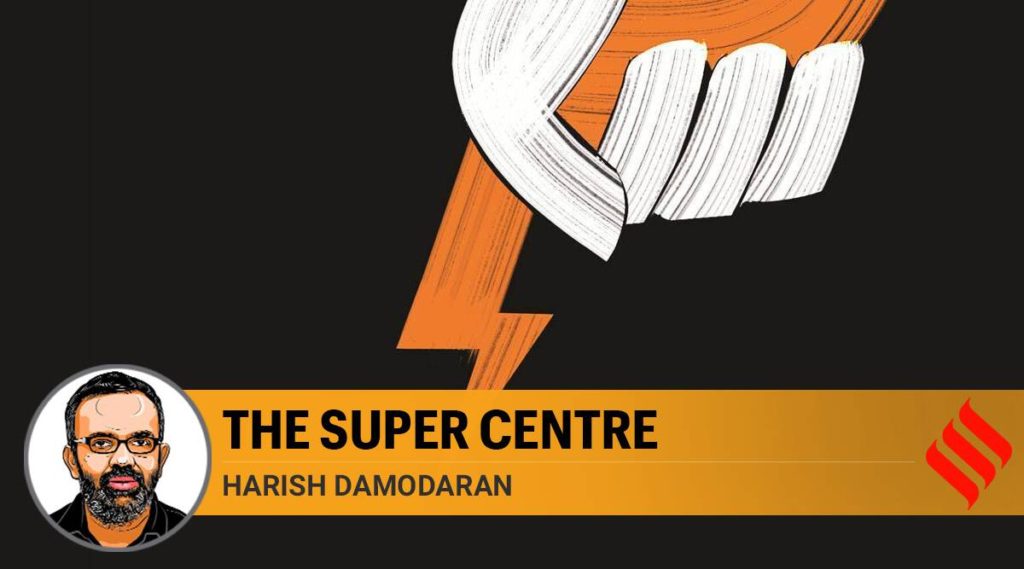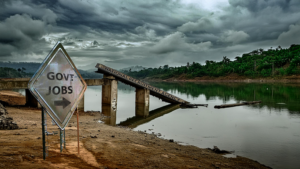The return of single-party dominance and its implications for politics after nearly 25 years of minority/coalition governments at the Centre (December 1989-April 2014) has been widely commented upon. As have concerns over rising corporate market power and their expression, whether in the ongoing protests against the three central farm laws or the grant of bank licences to industrial houses.
The recent Bihar election results — Nitish Kumar is back as chief minister, but of what is, for all practical purposes, a Bharatiya Janata Party (BJP) government — have reaffirmed a larger political trend. There are states that are still opposition-ruled — Punjab, Rajasthan, Maharashtra, Kerala, Tamil Nadu, Andhra Pradesh, Telangana, Chhattisgarh, Jharkhand and West Bengal. However, as many have noted, chief ministers today have been reduced to satraps. The real power is with the Centre, which has the all-important “agencies” and holds the purse-strings in these fiscally-challenging times.
For all their fulminations at not being compensated for shortfalls in GST revenues, states have had to accept whatever little the Centre offered through a special Option-1 borrowing window. The Maharashtra government couldn’t stop the Elgar Parishad case being handed over to the National Investigation Agency, while the Pinarayi Vijayan administration in Kerala has been a mute spectator to the Enforcement Directorate grilling its officials and a minister in connection with alleged money-laundering and gold smuggling probes.
What this analysis — of a single party under an unquestioned leader exercising total control over the nation’s polity — misses out, though, is a parallel and related phenomenon. That has to do with the increasingly “conglomerate” nature of Indian capitalism. These two centralisations — of political and economic power — reinforce each other. Its consequences are profound and have the potential to define the popular narrative in the days ahead.
Not too long ago, a significant part of political financing came not from large corporates as much as sugar and textile millers, cooperative barons, liquor and PWD contractors, grain traders/arhtiyas, land sharks, builders and miners. They were mostly regional capitalists who invested in provincial leaders. This translated into a decentralised crony capitalism model, where every party/politician had a chosen set of businessmen for bestowing favours and receiving funding in turn.
Howsoever repugnant, this model had some redeeming features. The mutually-beneficial partnership between the aspiring politician and the small-to-middling capitalist did allow for the emergence of new tycoons, including from diverse regional and social backgrounds. So long as the “cronies” and their political backers didn’t remain the same, it ensured a frequent reshuffling in the ranks of capitalists and also a competitive electoral democracy.
Consider this: The Nineties and Noughties were synonymous with not just coalition governments and regional parties taking centre stage, but also a period of “entrepreneurial capitalism” in India. The latter, one could argue, was more a result of the 1991 economic reforms that opened up new industries for private investment. But the fact that these avenues for capital accumulation were seized during a time of no single-party majority governments or a strong Centre cannot be missed. Nor can the fact that the period after 2014, despite being marked by political stability and the institution of a near-presidential system of governance, has seen more capital destruction than creation or accumulation (‘Death of enterprise’, IE, June 29, 2019).
Epitomising the above rise and fall are the “Andhrapreneurs” or businessmen from undivided Andhra Pradesh (AP). The promoters of GVK, GMR, Lanco, Madhucon, NCC, Nagarjuna Fertilisers, Navayuga, Soma Enterprise, Progressive Constructions, Sujana, IVRCL, Ramky Infra, SEW Infra, Transstroy, Sri City and Gangavaram Port were all liberalisation’s children. The first two post-reform decades was when many of them graduated from piecemeal contracting to constructing full-fledged national highways, airports, ports, power plants, irrigation dams, water supply systems, river bridges, tunnels and metro rail sections.
It is not a coincidence that the fortunes of the “Andhrapreneurs” grew precisely when its politicians were vital to propping up coalition governments at the Centre. The Telugu Desam Party was either part of non-Congress, non-BJP governments (in 1989-90 and 1996-98) or extended critical support to the first BJP-led ruling National Democratic Alliance from 1998 to 2004. Undivided AP also sent the largest contingent of Congress MPs to enable the formation of the United Progressive Alliance government in 2004 and 2009.
AP and Telangana are now both Opposition-ruled. But their irrelevance, if not deference, to the present dispensation at the Centre is matched by the decline of the “Andhrapreneurs”. There are very few survivors from the earlier-mentioned names — most have been consumed by the debts contracted during a not-too-distant past when animal spirits truly reigned. GVK only recently was forced to sell its prized Mumbai International Airport to the Adani Group, which has also acquired Navayuga’s Krishnapatnam Port.
The transition from “entrepreneurial” to “conglomerate” capitalism has obvious repercussions from an economic and business standpoint. In many industries — from telecom, airlines, steel, cement and aluminium to synthetic fibres, polymers, toiletries, tea and biscuits — there are now two, at most three, players holding dominant market position. Some groups have leadership straddling multiple sectors: Reliance (petrochemicals, telecom and retail), Tata (steel, commercial vehicles, salt and IT services), Aditya Birla (cement, aluminium and chlor-alkali) and Adani (ports, private power, branded edible oil and, next, airports).
But no less important are the ramifications for politics. The political scientist Adam Ziegfeld has shown that regional parties thrive when coalition governments are the order of the day. On the other hand, if single-party majority rule becomes the norm, political actors have little incentive to establish or join state-level parties that can share the spoils of power at the Centre. A corollary to this is that the regional capitalist no longer has ministers or MPs through whom he can get things done in New Delhi. They are as powerless as he is.
The absence of intermediation channels for medium-scale or even many large industrialists isn’t helped by the party at the Centre not really requiring their money. The BJP under Narendra Modi, like Indira Gandhi’s Congress in its time, faces no political competition within or outside. It can afford to operate a centralised funding system overwhelmingly reliant on Big Capital. Not only regional parties, even the once-powerful liquor, contractor, sugar or arhtiya lobby hardly matter in the new business-political oligarchy regime. Their support isn’t needed when unlimited large corporate financing is possible through electoral bonds that protect the donor’s identity and the contributions are tax-deductible to boot.
If the current agitation against the undermining of the traditional agricultural produce mandi system is any indication, the challenge to the oligarchy will come only from below. The political Opposition can latch on at best.
(The writer is Rural Affairs and Agriculture Editor at The Indian Express. Article courtesy: The Indian Express.)




